Search the Special Collections and Archives Portal
Search Results
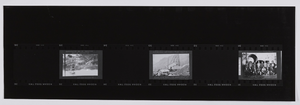
Film strip of individuals or Hoover Dam construction, image 012: photographic print
Date
1930 (year approximate) to 1939 (year approximate)
Archival Collection
Description
This photograph has three images. The first one (0272_0081) is upside-down and reads, "Record pour. Graveyard crew on No. 7 cableway. 240 8 cu. buckets. 8 hour shift, Boulder Dam. 12-18-34" There is a list on the back: "1. high-line operator 2. Bell boys hi-trussel and on dam. Andy 3. Donkey operators 4. Hook tenders 5. shifter, of crew (Colette) 6. Night Supt. Car Colette 7. Regular crew 8. Me. Returned to help crew for this record from form-raising crew. "All worked on No. 7 line in some capacity, except 8. Kizziar (KI-ZAH) -as a regular. Lots of work that day. Didn't take time for lunch. Run over to grab a bite and jump back. My job was to trip the safety (dog). Bucket was in the pour every two minutes. Just time to wade out of knee deep mud. On top trussel everything was panic. Bellboy sets an empty bucket in crib of flat car (which has three cribs). Hook tender unhooks it and donkey driver will back up to hook on full bucket. Bellboy signals hi-ball -- operator knows how far to take it." The other two images (0272_0082 and 0272_0083) did not have an inscription with the image.
Image
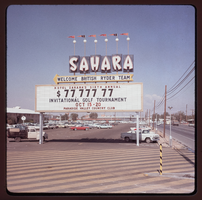
Marquee of the Hotel Sahara's 6th Annual Invitational Golf Tournament: photographic film
Date
1960 (year approximate) to 1969 (year approximate)
Archival Collection
Description
Marquee of the Hotel Sahara's 6th Annual Invitational $77,777.77 Golf Tournament, October 15-20 at the Paradise Valley Country Club. A smaller arrow-shaped marquee says "Welcome British Ryder Team". A sign for the Holiday Hotel is visible in the background. The Sahara Invitational was a PGA Tour event that was played in Las Vegas, Nevada from 1958 to 1976. From 1958 to 1961 it was called the Sahara Pro-Am and was not an official PGA Tour event. It was played at the Paradise Valley Country Club from 1962-1968 and from 1970-1971; and at the Sahara Valley Country Club (also referenced as the Sahara Nevada Country Club) in 1969 and from 1973-1976. The Sahara Hotel sponsored the tournament. Two tournaments were won here on October 20th, with the first tournament being won on October 20, 1963 by Jack William "The Golden Bear" Nicklaus with a final score of 276 over second place finisher Arnold Palmer, who shot a total of 285. Juan Antonio "Chi-Chi" Rodriguez won the second tournament on October 20, 1968 with a final score of 274, besting Dale Dwight Douglass, who tied with him at 274, in a sudden death playoff to take the title. Once owned by Howard Hughes, the Golf Club was re-named the Wildhorse Golf Club in 1994. The golf club is located at 2100 W. Warm Springs Road, Henderson, Nevada.
Image
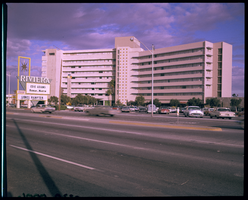
An exterior view of the Riviera Hotel and marquee: photographic film
Date
1960 (year approximate) to 1986 (year approximate)
Archival Collection
Description
An exterior view of the Riviera Hotel and marquee. The marquee is advertising "Edie Adams" "Rowan and Martin" "Starlite Lounge" "Lionel Hampton" "The Cousins" and the "Sawyer Sisters". The Riviera (colloquially, "the Riv") opened on April 20, 1955 as the first high-rise at 9 stories, and the ninth resort on the Las Vegas Strip. Liberace cut the opening ribbon, and became the first resident performer. The Riviera also broke new ground in its design: previously, Strip resorts resembled roadside motor courts. The Riviera underwent an expansion from 1988 to 1990 this included the 24 story Monaco Tower designed by Martin Stern Jr. and two parking garages. In February 2015, the Las Vegas Convention and Visitors Authority acquired the Riviera hotel and its associated land for $182.5 million. The property was leased back to its existing operators, Paragon Gaming, who officially closed the establishment on Monday, May 4, 2015. Due to its size, the Riviera was demolished through two separate implosions conducted in June and August 2016. The first implosion took place at 2:35 a.m. (Pacific Time) on June 14, 2016, taking down the 24-story Monaco tower. A firework display and countdown led up to the implosion. On August 16, 2016 at 2:30 a.m., the Monte Carlo tower along with the 12 story tower constructed in 1966 were imploded. The property was located at 2901 Las Vegas Boulevard South, Las Vegas, NV 89109.
Image
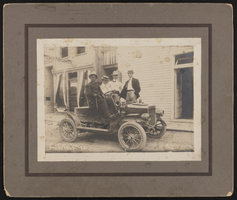
Joe Gans and others in an automobile: photographic print
Date
1906-07-04
Archival Collection
Description
Photograph was taken at 102 E. Ramsey Avenue, Goldfield, Nevada, in front of the Lewis Rogers, Attorney-at-Law Office. July 4, 1906. Joe Gans (left) with three unidentified men. One is most likely Rogers, his attorney. Handwritten inscription w/ image: "On Sept. 3, 1906, Joe Gans, known as the "Old Masta", fought Oscar "Battling" Nelson in Goldfield. The fight was promoted by Southern Nevada Mining magnate Tex Rickard. Nelson had come out of retirement for the bout saying "I want to settle once and for all that a white boxer can defeat a ------ any day." Gans, a negro, had come to begin his training in Goldfield in June 1906. Because Gans was was black, he was compelled by boxing promoters to permit less-talented white fighters to last the scheduled number of bouts with him and occasionally defeat him. The Gans-Nelson fight for the lightweight championship lasted 42 rounds and is considered the single greatest boxing performance in history. Gans won when Nelson deliberately fouled him. The fight brought in a purse of $75,000 and was attended by 6500 spectators, both records at the time. Blacks from across the country came to cheer on Gans and many stayed in town to work following the contest. Less than four years later, Gans would be dead of tuberculosis."
Image

Photograph of Howard Hughes at hearing, Washington, August 08, 1947
Date
1947-08-08
Archival Collection
Description
Description given with photo: "As Hughes Dropped "Blackmail" Charge - Washington, D.C., Howard Hughes, multi-millionaire air-plane builder, left, is shown leaning over the council table as he agreed to call of his "Blackmail" feud with Senator Owen Brewster at the end of today's heated session of the Senate Subcommittee's hearing of Hughes' wartime aircraft contracts. Committee members seated at the table (right) are: left to right: Senators J. Howard McGrath (D), Rhode Island: Claud Pepper (D), Florida: Homer Ferguson (R), Mich., chairman, and John J. Williams (R) del. spectators, reporters and photographers crowd around the committee table. Photograph by N.K. Benson 8/8/47." Another description given with photo: "Committee Closes Books On Hughes' Charges, Washington: Howard Hughes (right) exchanges remarks across the table with Sen. Homer Ferguson (R-Mich.), left, chairman of the Senate War Investigating Subcommittee, after the latter announced that the committee had closed its books on the inquiry into Hughes' charge that Sen. Owen Brewster attempted to "blackmail" him. Sitting next to Sen. Ferguson is committee member Sen. John J. Williams (R-Dela.), and standing directly behind Sen. Williams is Sen. Brewster (R-Maine), smiling broadly. Credit (ACME) 8/8/47."
Image
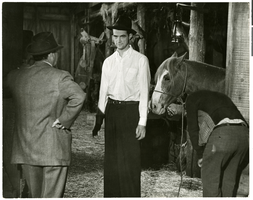
Photograph of Howard Hughes with Jules Furthman on the set of The Outlaw, Hollywood, circa 1941
Date
1940 to 1941
Archival Collection
Description
Howard Hughes (facing camera) talks with Jules Furthman (left), author of the story and screenplay of the motion picture "The Outlaw." Transcribed from attached press release: "From Russell Birdwell and Associates After an absence of ten years from motion picture production, Howard Hughes resumes film making with the producing and directing of "The Outlaw," the story of Billy the Kid, for Twentieth Century-Fox release. In 1931 he produced and directed "Hell's Angels," from which emerged a glorious new star, Jean Harlow, and in the same year he brought to stardom Paul Muni in "Scarface." And now Hughes, who in 1931 promised two new stars in Harlow and Muni, makes the same promise again with 19-+year old Jane Russell and 21-year old Jack Buetel, playing the top leads in "The Outlaw," the cast of which also includes Thomas Mitchell and Walter Huston. In this picture Hughes is discussing a story point with Jules Furthman, author of the story and screen play on "The Outlaw."
Image
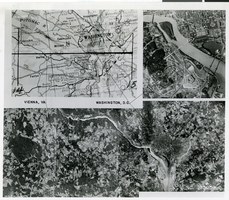
Aerial photograph of Potomac area, with map, demonstrating the Lockheed Shooting Star mapping plane, October 28, 1946
Date
1946-10-28
Archival Collection
Description
An aerial photograph with a city map in the upper left corner. Transcribed description from back of the photograph: "AAF' 'Shooting Star' does mapping at 475 mph. An Army Air Forces XFP-80, the 'Shooting Star' built by Lockheed recently made a 51 minute run from Wright Field, Dayton, Ohio, to Washington, D.C., photographing 16,000 square miles of territory along the route for mapping purposes. The flight established a new record in photographic mapping, covering 314 square miles per minute. A new tri-metrogen K-17-B aerial camera installation, consisting of three cameras positioned and times to record the terrain from horizon to horizon was used. The test flight proved the new jet type aircraft perfect for any Air Forces mapping job. Jets, due to the lack of vibration, allow perfect exposure in minute detail without the use of intricate stabilized camera mounts."
Image
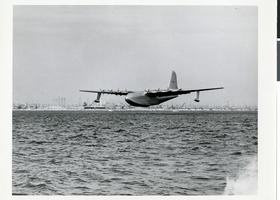
Photograph of Hughes Flying Boat during its test flight, November 2, 1947
Date
1947-11-02
Archival Collection
Description
Date stamped on back of photo: Nov 2, 1947. Transcribed from attached press release: "IN THE AIR Hughes Flying boat, with Howard Hughes at the controls, takes to the air at Los Angeles Harbor November 2, 1947. LONG BEACH, Calif., Nov. 2 - - Howard Hughes' 400,000-pound flying boat, world's largest plane, in the air on its first flight. The mammoth aircraft today flew one mile at a height of 70 feet over Los Angeles Harbor with Hughes at the controls. Hughes had scheduled taxi tests only for the 219-foot long ship but it 'felt so good' on the second taxi test run at 95 miles per hour that he took it off the water, as shown here, on the third and final run. The super plane's air speed was 100 miles per hour. Take-off speed was 95 miles per hour. Hughes termed the tests exceptionally successful. The eight-engine behemoth, launched yesterday off Terminal Island, passed its tests today in view of thousands on the shore and in small craft near the test area."
Image
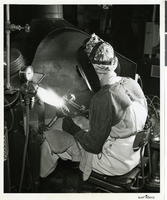
Photograph of new atomic-hydrogen welding process, Hughes Tool Company, Houston, Texas, circa 1929
Date
1929
Archival Collection
Description
Transcribed from press release attached to back of photo: "PENETRATES EARTH 16,000 FEET A surface approaching the hardness of the diamond is applied by a new atomic-hydrogen welding process to the teeth of a rock bit drill at the Hughes Tool Company plant in Houston, Texas, owned by Howard Hughes, noted aircraft designer-flyer. The first Hughes rock bit revolutionized oil drilling practices in this nation several decades ago, making possible recovery of oil beneath hard rock formations at great depths. Most recent models have penetrated the earth below 16,000 feet. Hughes drills are used in 50 foreign countries. NOTE: The atomic-hydrogen process differs from other arc-welding processes in that the arc is formed between two electrodes, rather than one electrode and the work." The patent on the atomic-hydrogen process was awarded October 29, 1929.
Image

Photograph of Howard Hughes sitting in the cockpit of the XF-11 preparing for his first test flight in Culver City, California July 7, 1947
Date
1947
Archival Collection
Description
Transcribed from press release attached to back of photo: "NEW PHOTO PLANE TEST-FLOWN CULVER CITY, California, July 7 -- Howard Hughes, who designed and built the new FX-11 reconnaissance plane in conjunction with Air Materiel Command engineers, sits in the pilot's bubble-glass canopy preparing for the first test flight. One of the world's fastest long-range photo planes, the XF-11 can attain a speed of more than 400 miles per hour, Army officials said. It is powered by two 3000-horsepower radial engines with eight-bladed contra-rotating propellers. Outstanding features include a full-span flap, unique eight-camera layout, and exceptionally fast take-off." Transcribed from photo sleeve: "Howard Hughes sits in the cockpit of the XF-11, a reconnaissance plane that Hughes built and designed in conjunction with Air Materiel Command engineers. Hughes is preparing for his first test flight in Culver City, California July 7, 1947.
Image
Pagination
Refine my results
Content Type
Creator or Contributor
Subject
Archival Collection
Digital Project
Resource Type
Year
Material Type
Place
Language
Records Classification
